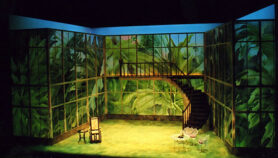Seminar Blogs
“Destabilizing Anthropocentrism in the Theater” – Elena Roznovan
 What struck me about Manuela Infante’s Plant Dramaturgy is the structural and processual decisions made to decentralize anthropocentrism so common in the cannon of theater. From the point of view of a playwright and director, Infante pushes the envelope of what theater is while simultaneously using the theater setting as a kind of laboratory in which she tests her ideas. To illustrate, I would like to circle back to the idea of destabilizing anthropocentrism in the theater, an overarching theme in her work. In her piece Estado Vegetal which is inspired by plant philosophy, Infante destabilizes human-centric discourse by introducing multitude. The ability to replicate itself or divide itself endlessly enables a plant’s survival. The reference to multitude is a strategy to move away from the concept of an individual, i.e. a human, and instead to reference plants. During the performance of Estado Vegetal there is one actress on stage with a looper-pedal channeling a multitude of voices. Infante uses the process of multitude as a way of embodying a plethora of characters through one actress and the help of a looper-pedal. This co-constitution of the play via the interaction between the actress and the looper-pedal points towards the decolonization of the theater from human-centric discourse. Because the looper-pedal makes possible the multiplicity of voices, and therefore characters, it becomes an equal actant vis-a-vis the human. In this sense, the constitution of the play is a result of the intra-action[1] of the looper-pedal and the human actor. Estado Vegetal transforms the theater into a space where non-human actants gain agency and, thus, confront typical anthropocentrism notion traditionally found in theaters.
What struck me about Manuela Infante’s Plant Dramaturgy is the structural and processual decisions made to decentralize anthropocentrism so common in the cannon of theater. From the point of view of a playwright and director, Infante pushes the envelope of what theater is while simultaneously using the theater setting as a kind of laboratory in which she tests her ideas. To illustrate, I would like to circle back to the idea of destabilizing anthropocentrism in the theater, an overarching theme in her work. In her piece Estado Vegetal which is inspired by plant philosophy, Infante destabilizes human-centric discourse by introducing multitude. The ability to replicate itself or divide itself endlessly enables a plant’s survival. The reference to multitude is a strategy to move away from the concept of an individual, i.e. a human, and instead to reference plants. During the performance of Estado Vegetal there is one actress on stage with a looper-pedal channeling a multitude of voices. Infante uses the process of multitude as a way of embodying a plethora of characters through one actress and the help of a looper-pedal. This co-constitution of the play via the interaction between the actress and the looper-pedal points towards the decolonization of the theater from human-centric discourse. Because the looper-pedal makes possible the multiplicity of voices, and therefore characters, it becomes an equal actant vis-a-vis the human. In this sense, the constitution of the play is a result of the intra-action[1] of the looper-pedal and the human actor. Estado Vegetal transforms the theater into a space where non-human actants gain agency and, thus, confront typical anthropocentrism notion traditionally found in theaters.
Besides pushing our traditional understanding of what constitutes a play, with Estado Vegetal Infante uses the theater as a laboratory for probing concepts. In this case, the concept of multitude derived from her research on plant characteristics is put to the test through the structure of the play. The play is composed of dissectible modules that branch out of each other inspired by the way a plant grows out of its branches. Each branch could be regrown into another plant, and similarly, the modules of the play could be regrown into new plays. So, the play could be seen as a multitude of modules that come together in a non-linear way to narrate a story. The theater, here, becomes the observation apparatus[2] in the sense that it processes Infante’s idea for a branching out structure for the narrative of Estado Vegetal and indicates its success. For Infante, the theater is similar to a lab where successful experiments validate certain ideas through the materialization of plausible results. These results can be seen as feedback performed by a non-human entity. Thus, the author or play-write engaged in a co-creative act with the theater which provides feedback, and by doing so is an invisible co-author of the play.
[1] I borrow the concept of intra-action from Karen Barad who defines it as the co-creative act of mutual constitution between two entangled agencies (2003).
[2] In Karen Barad’s text “Posthuman Performativity: Toward an Understanding of How Matter Comes to Matter” observation apparatus are defined as ‘materially-discursive’ practices that set up particular conditions of possibility between human and non-human agents and thus produce specific meaning (2003).
References
- Barad, Karen. 2003. “Posthuman Performativity: Toward an Understanding of How Matter Comes to Matter.” Signs. Journal of Women in Culture and Society 28, no. 3, 801-831. https://www-journals-uchicago-edu.proxy.library.uu.nl/doi/pdfplus/10.1086/345321.
*Image credits: “Suddenly Last Summer” by lisascenic is marked with CC PDM 1.0

